Author’s Corner: David Clay Large
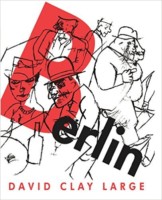
David Clay Large is a professor at The Fromm Institute, University of San Francisco, and a Senior Fellow at the Institute of European Studies, U.C. Berkeley.
His book BERLIN has been very well-received, with Dr. Dorothee Brantz saying “this book is a captivating read; just like a good novel, it is hard to put down.”
Recently, I caught up with David for this interview:
1) How did you become interested in the history of Berlin?
My interest in Berlin began when I visited the city as an exchange student to Austria in the early sixties. The Wall had recently gone up and the town was alive with tension. At that time, I already knew I wanted to be an historian, and it quickly became apparent to me as I walked the streets of West Berlin, and also crossed into East Berlin on a 12-hour visa, that this place was chock-full of historical sites and references. (The fact that many of the sites were in ruins made them all the more poignant and fascinating.) In graduate school at Berkeley, I specialized in German history, which made me acutely aware of Berlin’s centrality not only in the development of modern Germany but also in world events over the past century or so. Although I didn’t focus on Berlin immediately in my scholarly career, I had the itch to write about it early on, and when an editor approached me in 1990 with a proposal to take on a full-scale modern history of the city, I jumped at the opportunity. It turned out to be a long jump, a ten-year leap.
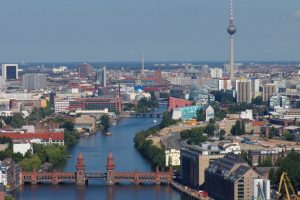
(View of Berlin)
2) What do you think are some of the most significant developments in Berlin since the time your book was published?
By far the most significant development in Berlin between 2000 and 2016 is the huge influx of refugees and migrants from the Balkans, Africa, and (above all) the Middle East. Berlin had long been a haven for refugees and immigrants, but this most recent influx, especially the 62,000 new arrivals in 2015 alone, has tested Berlin’s social services and immigration bureaucracy like never before. The reception process has been extremely chaotic, undermining Germany’s reputation for efficiency and even-handedness. The city’s reputation for tolerance and openness to the “other” has also taken a hit due to a nativist backlash. The racist reaction to the immigration crisis may not be as strong in Berlin as in other parts of Germany (especially Saxony and Bavaria), but right-wing populist anger and influence is much stronger in the capital now than it was in 2000.
Another significant development also involves in-migration, in this case on the part of wealthier folks from other parts of Germany and abroad. These relatively deep-pocketed people have streamed into the once-shabby neighborhoods of eastern Berlin (such as Prenzlauer Berg and Friedrichshain), gentrifying them and gradually pushing up the cost of housing. Thus Berlin has become considerably less affordable for those impecunious artists, musicians, teachers, and street philosophers who were largely responsible for the town’s reputation as the hippest place on the planet. That image of hipness – “poor but sexy” in the the words of former mayor Klaus Wowereit – has worn a bit thin as the city has gotten more comfortable and less edgy (though not, of course, anywhere near as comfy as Geld-geműtlich Munich). Still, there is too much chest-thumping in Berlin about coolness, as if the inhabitants weren’t quite sure the term still fully applies. Today’s Berlin somehow manages to be self-satisfied and insecure at the same time.
Revealing, too, are two mega-construction projects that are not unprecedented in their ambition — (Berlin in the 1990s was one big construction site) — but still have managed to explore new territory in financial mismanagement, waste, and sheer incompetence. I’m speaking of the Berlin-Brandenburg airport fiasco, a $6 million embarrassment that, like Germany’s migrant-processing woes, belies the national reputation for efficiency, and the City Palace façade reconstruction, a vastly expensive and aesthetically reactionary exercise in nostalgia.
3) Please compare and contrast how Americans outside of NYC view New York, with how Germans outside of Berlin view the German capital.
There are a lot of similarities: many Americans west (and south) of the Hudson view New York as not-quite-American in its extreme diversity, exotic avant-garde culture, moneyed elite, and liberal politics (even Donald Trump, a New Yorker himself, tried to play the anti-New York card in his populist presidential campaign); many Germans beyond the Spree, for their part, see Berlin as “un-German” for its diversity, exoticism, “alternative” culture and life-styles, left-leaning politics, etc. That said, I would argue that Berlin is somewhat more cherished by non-Berliner Germans than NYC is by non-New Yorker Americans. After all, Berlin overcame political division and isolation and returned as Hauptstadt in a country desperate for a capital worthy of its importance in the world. Berlin also reasserted itself as a world city – something that NYC has not had to do in modern times – thereby becoming an article of pride for many Germans. (School classes in Germany visit Berlin, while their American counterparts visit Washington D.C. or Colonial Williamsburg.) For most Germans, Berlin carries enormous historical weight, while NYC has to share such symbolic heft with Washington, Philly, and Boston—and must share cultural influence with L.A., Chicago, and San Francisco. True, Munich, Hamburg, and Frankfurt compete with Berlin in financial, commercial, and cultural affairs, but since reunification Berlin has significantly outdistanced its municipal rivals in world-political clout and cultural cachet—overpowering cities that until quite recently looked down their noses at poor, divided, and isolated Berlin. On the other hand, NYC leads Berlin in one important sense: since 9/11 it attracts respect and sympathy among Americans as the country’s premier symbol of national victimization and vulnerability in an age of terror. We can only hope that Berlin does not likewise achieve this dubious distinction within Germany.
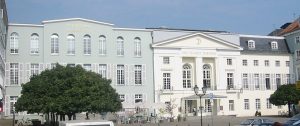
(Photo of Deutsches Theater, Berlin by Andreas Praefcke)
4) What are some of your favorite things to do in Berlin?
I have a lot of them. Upon arriving in Berlin I always make a bee-line for the original Cafè Einstein on Kurfűrstenstrasse. In good weather, I take a seat outside and exchange knowing glances with my fellow slackers. As an historian who has written about German resistance to Nazism, I usually make a pilgrimage to the Memorial Center at Plötzensee , where many of the 20th of July resisters were hanged on meathooks. I take walks in the Tiergarten and out around the lake at Wannsee, where I sometimes also visit the Haus am Wannsee historical exhibit. For a bracing bit of contemporary culture, I visit the Kűhlhaus, and for a trip into the past (an expensive one at that) I dine at Horcher’s Restaurant (though emphatically not in a bow to the top Nazis who used to favor the place). Another must-visit is the German Historical Museum on Unter den Linden, which has a great permanent collection as well as hugely intriguing temporary exhibitions. And finally, I like to stroll around the Kollwitzplatz and examine the ever-changing cafè, bar, and boutique scene there. There’s also a bookstore in the neighborhood, which, alas, is more than one can say for all-too-many sections of the city.
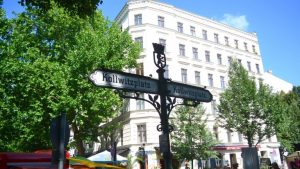
(Kollwitzplatz, Berlin)
5) Please tell us about your upcoming projects.
These days I write off and on for Foreign Policy Magazine about contemporary affairs. I continue to give lectures around the world on the Olympic Games, about which I’ve written two books, and on the Grand Spa-towns of Central Europe, which is the subject of my most recent book. My next writing project will (probably) be a book-length study of various key episodes in World War II that have continued to be fought over in memory, commentary, commemoration, and politics down to our own day.
****
David Clay Large’s books include:
1) Berlin;
2) Nazi Games; The Olympics of 1936;
3) Munich 1972; Tragedy, Terror, and Triumph at the Olympic Games;
4) And the World Closed its Doors; The Story of One Family Abandoned to the Holocaust;
5) The Grand Spas of Central Europe

(Photo courtesy of author David Clay Large)
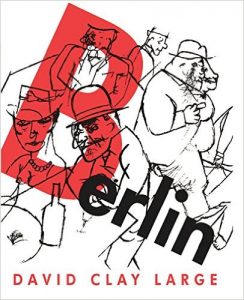
Another great interview, Joanne! When it comes to Berlin, David is, as they say, a kenner! Just fix the cost of the airport to say $6 billion, not million (which would be quite a bargain.)